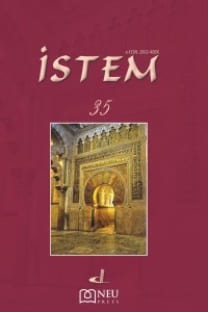KUR’AN-I KERÎM KİTÂBETİNİN ESTETİK TEMELLERİ
Akıl, ruh ve zevklerini kusursuz bir hale getirerek derin bir sevgi gücüne kavuşan sahabîler, medeniyetin asıl kaynağı olan Kur’ân-ı Kerîm’i bu yönleriyle ele almışlardı. Dolayısıyla onu İslâm medeniyetinin şah eseri yapacak kitâbet çalışmaları da bu devirde başlamıştı. İslâm Medeniyeti’nin en parlak dönemlerinde bile vücuda getirilen bütün sanat eserlerinin estetik açıdan tarifleri ilk olarak Hz. Peygamber tarafından yapılmıştır. Mescid-i Nebî, ilâhi sanatın mekâna yansıması olarak bütün unsurlarıyla mimariye örnek olurken, sesleri güzel sahabiler de o ilâhi sanatın sesteki ahengi itibariyle tercih edilmişlerdi. Aynı şekilde, İslâmiyet hattı ve kitabeti zaruri kılmış, kullanma sahasını geliştiren hükümleri de beraberinde getirmişti. Başta peygamberimiz olmak üzere, kitâbet hususunda ehliyetli olan sahabiler, o dönemde kullanılan yazının ilâhi bir sanat eseri olan Kur’an-ı Kerîmle uyuşmadığını fark etmişler ve hummalı bir çalışma içine girmişlerdi. Buna bağlı olarak Kur’ân-ı Kerîm’in kitap haline getirilmesinden evvel yazının ıslah çalışmaları başlamış, bu konuda ilk muallim ve mürebbî bizzat Hz. Peygamber olmuşlardı. O’nun Besmele’nin harflerine yönelik katibine yaptığı tarifler ise, hat sanatının öğretilmesinde esas olan meşk usulunün de temelini oluşturmuştur
Anahtar Kelimeler:
Hüsn-i Hat, Kur’ân-ı Kerim, Besmele, Meşk, Sahâbe
The Aesthetic Basics of the Scription of al-Qur’an
Having acquired a profound power of compassion by perfecting their minds, souls and tastes, the sahaba dealt with the Qur’an, which is the real origin of civilization, in this aspect. Therefore, activities aimed at literary composition to turn it into a masterpiece of Islamic civilization also began in this period. The aesthetic definitions of all works of art that were produced in the most glorious periods of the Islamic civilization were first made by Prophet Muhammad himself. While al-Masjid al-Nabawi served as an example for architecture in all its aspects as a reflection of divine art on space, the sahaba with beautiful voices were preferred as a corresponding component of that divine art in voice. Likewise, Islam made calligraphy and literary composition obligatory and imposed edicts that expanded their area of application. The Sahaba, who were proficient in literary composition, and above all our Prophet noticed that the script used at the time was not suitable for the Holy Qur’an, which was divine work of art, and engaged in an arduous endeavor. In the same context, efforts aimed at improving the script had begun before compiling the Holy Qur’an in the book form and our Prophet became the first teacher and trainer in this respect. The descriptions that he made to his scribe about the letters of Basmalah laid the foundations for the method known as mashk, modeling, which is essential in the teaching of the art of calligraphy
Keywords:
Islamic Calligraphy, Holy Quran, Basmalah, Mashk, Sahaba,
___
- Kaynaklar: Kaynaklar: Kaynaklar: » BERK, Süleyman; “Kur’an-ı Kerim Nüshalarının Hat ve Hattatları” 1400.Yılında Kur’an-ı Ke
- rim, İstanbul 2010, s.57-86. » BUHARİ, el-Câmiu’s-Sahîh 1-4, Kahire 1400. » ÇETİN, Nihat M.; “İslam Hat San’atının Doğuşu ve Gelişimi (Yakut Devrinin Sonuna Kadar)”,
- İslam Kültür Mirasında Hat San’atı (ed. Ekmeleddin İhsanoğlu), İstanbul 1992, s.14-32. » İBN-i MACE, Sünen 1-6, Beyrut 1998. » İBN-i NEDİM, el-Fihrist, Tahran trz. » KETTÂNÎ; et-Terâtibü’l-İdâriyye, I-II, Rabat 1346-Beyrut trz. » KUTLU, Hüseyin; (Sunuş) AK, Ahmet Şahin, Türk Din Musikisi, Ankara 2009. » SERİN, Muhittin; Hat Sanatı ve Meşhur Hattatlar, İstanbul 1999. » SERİN, Muhittin; Hat Sanatı ve Meşhur Hattatlar, İstanbul 2003. » SİCİSTÂNÎ; el-Mesâhif, Mısır 1936. » YAZIR, M. Bedrettin; Medeniyet Aleminde Yazı ve İslam Medeniyetinde Kalem Güzeli, Anka- ra 1972.
- ISSN: 1304-0618
- Yayın Aralığı: 2
- Başlangıç: 2003
- Yayıncı: N.E.Ü.İlahiyat Fakültesi İslam Tarihi ve Sanatları Bölümü
